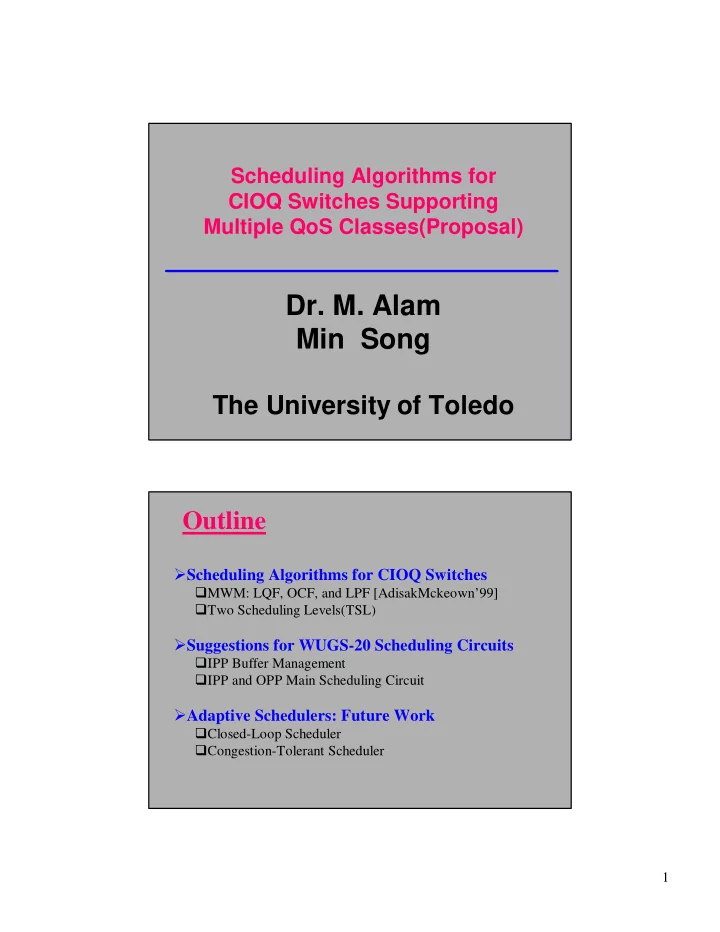

Scheduling Algorithms for CIOQ Switches Supporting Multiple QoS Classes(Proposal) Dr. M. Alam Min Song The University of Toledo Outline � Scheduling Algorithms for CIOQ Switches � MWM: LQF, OCF, and LPF [AdisakMckeown’99] � Two Scheduling Levels(TSL) � Suggestions for WUGS-20 Scheduling Circuits � IPP Buffer Management � IPP and OPP Main Scheduling Circuit � Adaptive Schedulers: Future Work � Closed-Loop Scheduler � Congestion-Tolerant Scheduler 1
LQF,OCF, and LPF(1) � LQF : Picks a match such that the sum of serviced queue’s occupancies is Q , Q , Q , maximized. But if > always, then would never be serviced. i j i k i k � OCF : Select a match such that the sum of all serviced queue waiting times is maximized. R i ( n ) C j ( n ) L ( n ) + , > 0 w i , j = i , j 0, otherwise N N = ∑ = ∑ � LPF: R i ( n ) C j ( n ) L ( n ) L ( n ) and i , j i , j i Step 1: Sorting j 1 Sort inputs & outputs based on their occupancies 2 Reorder requests according to their input and output occupancies Step 2: Matching 1 for each output from largest to smallest 2 for each input from largest to smallest 3 if (there is a request) and (both input and output unmatched) 4 then match them LQF,OCF,and LPF(2) � All these three algorithms can find a MWM � They can achieve 100% throughput for all admissible independent arrival processes But… � They don’t make any distinction among the VCs and the cells in each VOQ. So it may not be fair for those VCs that share the same port pairs but have the diverse b/w requirements. Some oldest cells (low priority) deserve staying there longest time or the newest cells (high priority) need to leave earlier. � LOL more focus on the switch performance, less VC QoS 2
Two Scheduling Levels(TSL) Per-VC VOQ G1 crossbar of no buffer with G2 Speedup 2 L1 L2 G3 or crossbar of buffer without Group Classification: speedup G1: real-time traffic, CBR and rt-VBR G2: non-real-time traffic, nrt-VBR and ABR G3: best effort, UBR Any VOQ overflow will cause L1 first stops servicing G3, then G2. Scheduling Level 1 Per-VC VOQ G1 � L1: G1 � Flow level; Can be implemented G1 on SPC/FPX L1 L2 � Need information: priority b/w reservation destination L2 VOQ overflow feedback � Group Service Policy G1 G2 G3 � Within each group, VCs are serviced according to the b/w reservations HOL cells are selected based on their Virtual Finish Times(VFT) Smallest VFT First VFT can be calculated on SPC 3
Scheduling Level 2 Per-VC VOQ G1 � L2: � G1 Switch level G1 � L1 L2 Need global information port length VOQ priority � VOQ priority high priority cells more weights low priority less weights � Match selection: Weighted LPF(WLPF) Step 1: Calculating each VOQ priority Step 2: Sorting 1. Sort inputs and outputs based on their weighted occupancies 2. Reorder requests according to their weighted inputs and outputs occupancies Step 3: Matching (same as LPF) Challenge: L2 is a central scheduler. It needs global information. This makes it hard to be implemented in large switches. Level 2 for WUGS-20 � L2: Per-VC VOQ � Port level G1 � Need global information G1 Grant signal from SE G1 VOQ priority L1 L2 � VOQ priority high priority cells more weights low priority less weights � VOQ selection Highest Priority First(HPF) 4
IPP Buffer Management Single FIFO buffer RCB 32 RCV VXT RFMT CYCB 16data 2control RCB (1) No traffic isolation. It may be unfair to good-behavior users; (2) Does not distinguish among VCs(priority, rate…). H ard to guarantee the real-time traffic QoS . Suggestions: VOQ or CBQ. IPP and OPP Main Scheduling Circuits TS=MREG.Time TS=VFT RCB 32 RFMT CYCB RCV VXT 16data 2control Smallest VFT First MR Transmit Transmit Block Transmit Re- Re- Framer Buffer Discard Circuit Sequencer Formatter 166 Circuit 80 Cell Store 256 5
Closed Loop Scheduler Per-VC VOQ G1 G2 L1 L2 G 3 RM.ER.ABR Queue occupancy RM.CI � The backward RM.ER directly affects the value of VFT for ABR connection � L2 Scheduler should favor the port pair that has the longest input occupancy and the shortest output occupancy � If RM.CI=1, then all VOQs and Per-VCs that aim to that link are marked off Congestion-Tolerant Scheduler Once the congestion occurs at a particular link, the output queue will keep growing until the backward RM cell comes back to the source and forces the ABRs to reduce their rates. During this RTT time, the scheduler should stop deliver any cell to this port and buffer those cells at the input side as many as possible. So other ports can share the freed SF b/w. For example LPF: Step 2: Matching 1 for each output from largest to smallest 2 for each input from largest to smallest 3 if (there is a request) and (both input and output unmatched) 4 and (RM.CI=0) 5 then match them 6
Summary 1. Scheduling algorithm for CIOQ switches. We also present the TSL that can be implemented on SPC/FPX 2. Two suggestions for the current WUGS-20 scheduling circuits 3. Briefly present two schedulers for future work Acknowledgements Many thanks to Dr. John W. Lockwood We also thank Dr. Hui Zhang(CMU) and Dr. Nick Mckeown(Stanford University) Thank Mr. Andreas Festag(TU-Berlin) Thank Mr. Masayoshi Nabeshima(NTT, Japan) 7
Recommend
More recommend